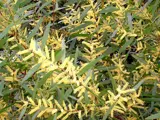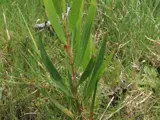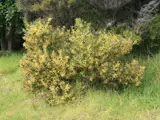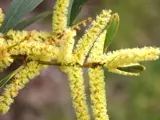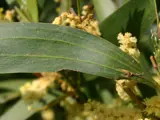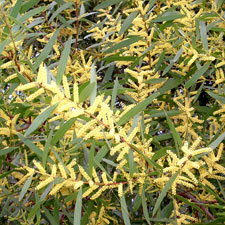 Sydney golden wattle
Sydney golden wattle
Common name: Sydney golden wattle
Botanical name: Acacia longifolia
Management programme: Sustained control - Rule 5a applies
Sydney golden wattle is native to Australia, and even in its native habitat, it is considered a pest of some coastal areas. It was widely planted in New Zealand as a garden ornamental and restoration plantings. Can reach 7-10m in just five to six years.
Why is it a pest?
- It invades open habitats and forms dense shady stands. The dense stands displace native species, change the habitat structure and increase risk of fire and erosion.
- Produces large quantities of seeds that can be transported by wind, water or soil movement.
- Seeds remain viable in the soil for up to 50 years.
Where is it found?
Found in coastal areas throughout the Bay of Plenty. It grows well on coastal dunes, riparian areas, dry banks, transport corridors, scrub and open forest. It is tolerant to salt spray thanks to its leathery leaves.
What does it look like?
- A shrub or small tree that grows to 10m.
- Leaves are narrow and leathery to the touch. They also have two prominent veins.
- Flowers are pale to golden yellow and can be seen from July to August.
- Flowers arrange themselves as spikes coming off the branch. The flowers themselves are small and clump together to form the longer spike shape.
- Has a seed pod that can grow to 12cm long and hangs either straight or slightly angled. Feels slightly papery to the touch.
- Twigs are sharply angled.
- The bark of the tree is smooth and slightly greyish.
What are the rules?
Sustained control
Sustained Control pests are well established in the region and preventing the spread is no longer a realistic objective. Management focuses on reducing general impacts of the pest. Landowners/occupiers are responsible for the control of these pest species on their land. Council may enforce control.
Under rule 5a of the RPMP landowners/occupiers must destroy this pest if required by a written direction from an authorised person unless a property specific pest management agreement has been agreed and signed between the occupier and the Council.
Criteria to meet Rule 5A include when the species is being actively managed by council, other agency and or community group, on an adjacent property. See the Regional Pest Management Plan 2020-2030 rules for Sustained control pests for more information.
How do you get rid of it?
- Hand pull small plants year round.
- Drill and fill with herbicide.
- Cut the trunk as close to the ground as possible. Paint the newly cut stump with herbicide.
- Foliage spray in spring and summer with herbicide and penetrant.
If hand pulling, try not to disturb the soil too much. This may encourage new growth of seeds already in the ground.
Plants can remain in situ to rot down. If there are just a few plants, you can dispose of all plant material at a refuse station in general waste.
CAUTION: When using any herbicide or pesticide, PLEASE READ THE LABEL THOROUGHLY to ensure that all instructions and directions for the purchase, use and storage of the product, are followed and adhered to.
Read more on pest control advice, information and regulations
Images

